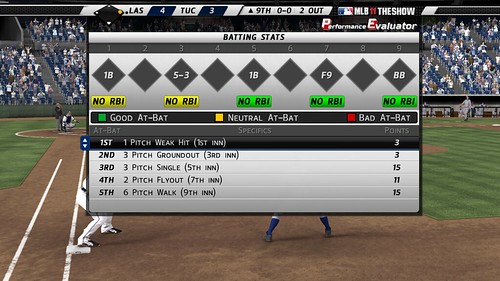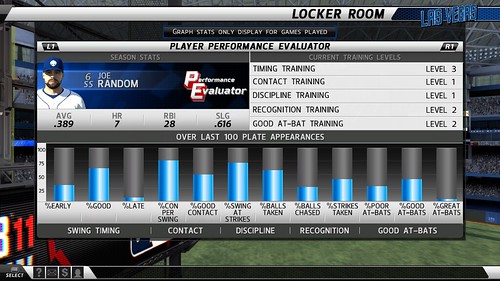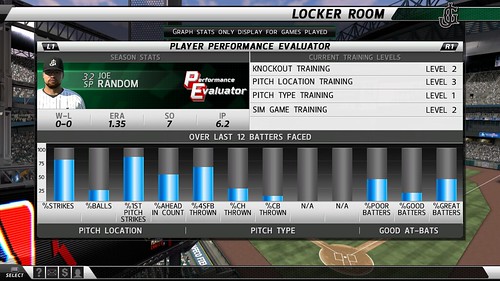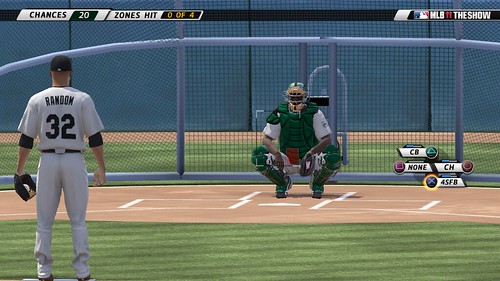Brand new to MLB 11 The Show this year, and to Road to The Show, is the Player Performance Evaluator. This new system analyzes your approach at the plate (or to batters faced) to then grade you, and in turn, provide training points. There are a number of factors that determine if the at bat was good or not, which include things like the amount of pitches during the at bat, the type of contact of the hit, and the overall result of the play. In general, the more pitches you see during the at bat, the better your chances are to receive a good result regardless if the at bat ended in a hit or not. However, ripping a first pitch strike for a home run will always be considered a good result. This result scale holds true for pitchers as well, although the system is the opposite so what a batter does that’s considered a success will likely be a bad result for the pitcher. We then take the result of each at bat and reward you with training points. The scale is vast in what levels of points you can achieve so for example, a one pitch single resulting in a good at bat will likely net you fewer points than an eight pitch single would.

Not only do we summarize your at bats, but the system also evaluates several things during each at bat to determine areas you excel in or fall short in. For batters, we evaluate your swing timing, contact quality, plate discipline, pitch recognition, and finally your overall at bat results. This data is tracked for your most recent 100 plate appearances and is displayed in the locker room screen, under the Player Performance Evaluator tab.

For pitchers, we keep track of your strikes versus balls thrown, percentage of first pitch strikes, percentage you work ahead in the count, a breakdown of your pitch type tendencies, and finally your overall batter’s faced results. The same holds true with batters in that the data is tracked for your most recent 100 batters faced.

After we’ve tracked enough data to establish your play style tendencies, we then determine the areas you need to improve on and trigger the training session that best suits that area. The training modes have been overhauled for batting and pitching this year to now focus on specific areas for each. The new batting training modes include timing training, contact training, discipline training, recognition training, and good at bat training. The new pitching training modes include knockout training, pitch location training, pitch type training, and sim game training.

Each of these trainings have their own specific purpose. For instance, in timing training your goal is to hit the ball fair with well-timed swings – swings that are too early or too late will count against you. For pitch type training, you will be told what pitch to throw and given a target for the location. Hitting the target with a different pitch or missing the target will not reward you. Each of these trainings also have levels of difficulty ranging from 1 to 5. In Road to The Show, you’ll start at level 1 and once you achieve the target success for that level, you’ll unlock the next level. Each level brings a new set of challenges so for example, level 1 timing training will require you to have 7 successes, whereas level 4 will require 10.

We’re very excited about this year’s new Performance Evaluator and training mode additions and hope you are as well. Thanks for reading and don’t forget to pre-order your copy MLB 11 The Show on PS3 to get 30 days FREE MLB.TV! We were able to get a few test codes to check out last year’s games and this really is a cool app. Follow your favorite team home or away on your PS3 with MLB.TV.
Welcome to The Show!
